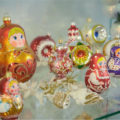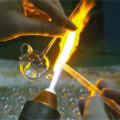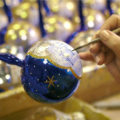The History of Christmas Tree Decorations in Russia
Every December the air is filled with the smell of spruce needles. Shop windows and shelves draw customers indoors with an abundance of sparkling decorations. It’s time to take the Christmas tree decorations out of storage, where they’ve been waiting, carefully wrapped in cotton wool and paper. These are the little harbingers of the country’s main holiday.
In Russia, the spruce became a symbol of the New Year and Christmas in 1700 with the decree of Peter I. According to his decree, on the eve of the holiday conifers had to be installed in the streets, squares, and courtyards of houses. However, the tradition of embellishing these trees didn’t appear until more than a hundred years later. At first, the trees were decorated with fruits, nuts, and all kinds of sweets. Later, “inedible” toys were added: usually these were household items, ribbons, and women’s trinkets. In rich houses ladies would hang their jewelry on the Christmas tree.
Real Christmas tree decorations, made especially for the Christmas tree, appeared in Russia in the middle of the 19th century. Decorations were imported from Germany and were expensive, so only very wealthy people could afford to decorate the Christmas tree with heavy balls and icicles made by German craftsmen. Papier-mache ornaments, made from thin metal and dried paper pulp, were also brought to Russia from Europe, but many people could not afford them either. It was during this period that the tradition of hand-making Christmas tree decorations from wax, wood, cardboard, and cotton wool appeared in the life of Russian families. At the same time, the Christmas tree decoration began to acquire national characteristics: homemade angels, figures of people and animals, lanterns, and garlands would appear not only in people’s homes but also at the first Christmas markets.
The popularity of the tradition grew by the year: special artels and family workshops for the production of Christmas tree decorations began to open, and the range of toys expanded. For example, peasants of the village of Danilovo near Moscow established a toy trade, which originated from the production of lamps and candlesticks. In the city of Sergiev Posad wooden toy craftsmen carved characters of Russian folk tales. Many women and children took part in the process of making Christmas tree decorations, and secrets and skills of production were passed down from generation to generation.
It was only at the end of the 19th — beginning of the 20th centuries in Russia that the production of glass toys began to operate, based in glass-blowing workshops. The oldest production facility was located in the Klinsky district of the Moscow region. It is called “Yolochka” and operates to this day. Klin craftsmen blew glass balls, kept them in a solution that contained lead, then dried them, painted and strung on a string. This is how the famous beads with their metallic luster came to be and became an inseparable element of the Christmas tree decoration of every home. The industrial production of glass New Year’s decorations began to develop in the 1930s. Russian craftsmen were able to master the technique of making cardboard, however, continued to make papier-mache figures by hand.
Over time, the Christmas tree decoration became not only a symbol of the upcoming holiday but also a reflection of the era. Everything new that entered our life was immediately hanging on the tree in the form of a toy. Figures of pioneers appeared on the branches of New Year’s trees next to the fairytale characters, and glass vegetables and fruits peacefully coexisted with planes, airships, and parachutists. During the Great Patriotic War the production of these toys decreased but did not stop completely. During this period, the figures of soldiers, tanks, medic dogs, and other decorations, made from the remnants from the sewing of military uniforms, wire, and medical bandages, began to be seen on New Year’s trees. In the era of human space exploration, satellites, rockets, and cosmonauts glittered on Christmas trees. Thanks to the achievements of Soviet athletes, the New Year’s collections were replenished with the figures of skiers, figure skaters, and hockey players.
It should be, however, noted that at all times the main part of the Christmas tree decoration consisted of the traditional balls, icicles, snowflakes, heroes of children’s fairy tales, animals, and etc. because the New Year tree, first of all, symbolized a children’s holiday.
In modern Russia Christmas tree can be decorated in numerous ways to satisfy every taste and budget. Decorations painted in the national style of Gzhel, Khokhloma, and other techniques of decorative and applied art, started to become fashionable. Christmas decorations in the form of matryoshkas and balalaikas are traditionally popular among foreigners. The concept of an exclusive or bespoke Christmas tree toy emerged. Such decorations can be a wonderful gift but just like in the old days they are not available to everyone.
Despite the abundance and variety of New Year’s decorations, the tradition of hand-making Christmas tree decorations has survived to this day: before New Year an exciting and creative work begins in families, kindergartens, and schools.
The fragility of the Christmas tree decoration made it a collector’s item. Unfortunately, very few ancient copies made in Russia have survived to this day. A rich and very interesting collection of New Year’s decorations is presented at the Museum of Christmas-tree decorations in the city of Klin.
The tradition of decorating the Christmas tree is one of the most beloved traditions in Russia. For children, this tradition means always holidays, magic, and, of course, gifts, and for adults, an opportunity to plunge into childhood memories and to tell family stories. Not a single children’s holiday is complete without a Christmas tree: round dances are performed around it, New Year’s songs are sung, and poems, dedicated to this tree, are recited. Adopted from Europe and over the course of 300 years this New Year’s tradition has become strongly Russified, becoming an integral part of culture.
Darya Serzhenko



